Summary
Research shows that even at a time of unprecedented political and economic turbulence, UK employees are still firmly committed to taking holidays, which remain a spending priority for them.4 Out of 22 countries worldwide, across North America, Europe, Australia and the Middle East, British employees are the most likely to take all their paid annual leave.5
Thinking about holidays as ‘an extended period of leisure and recreation, especially one spent away from home or travelling,’ freelancers took an average of 24 days of holiday in the last 12 months – slightly less than the 28 days of holiday UK employees are entitled to take every year.6
The number of days off freelancers take, however, varies considerably. One in ten (9%) freelancers did not take any days off in the last year and one in seven (14%) took less than five days. In contrast, a third (34%) took 25 days or more and one in seven (13%) took 40 or more. This reveals a group of freelancers who don’t take any break from their work. More encouragingly, however, there is a significantly larger group who enjoy the freedom and flexibility associated with being self-employed and take more days off than the average employee.
The data shows that taking time off is not dependent on a respondent’s earning potential. This is despite previous research suggesting that among the self-employed, higher earners are more likely to take holidays.7
One factor that does influence the amount of time off taken is age. Younger freelancers (16-34 years) are more likely to take more days off. A third (32%) take more than 30 days off a year in comparison with a fifth (22%) of those over 55. Younger freelancers are also more likely to report wanting to take more days off than they currently are.
The vast majority of respondents said they would prefer to take more days off, with four in five (78%) saying they would like to take more holidays and only seven per cent saying they would like to take fewer.
On average, freelancers would like to take 38 days off a year – 14 more than they currently take. One in six (16%) are happy with the amount of days off they take a year and don’t want it to change.
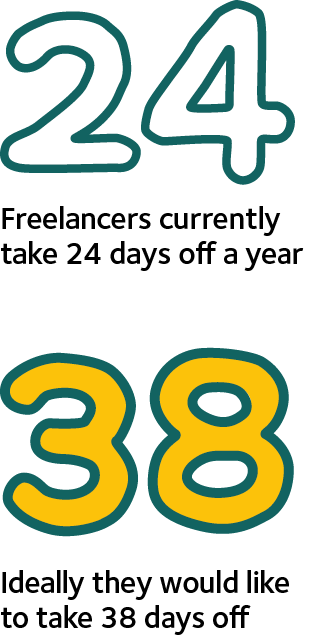

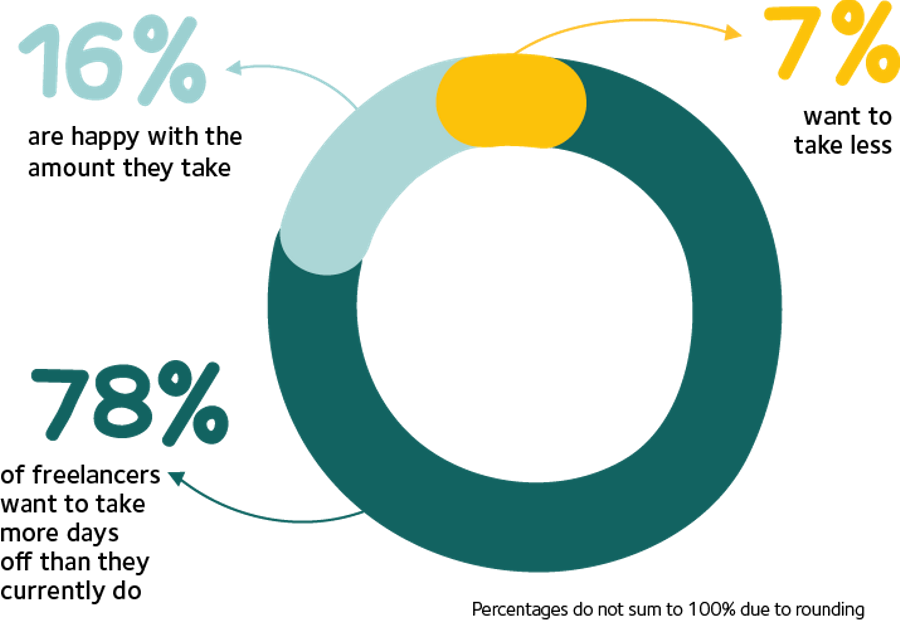
The research shows that taking time off has a substantial positive impact on the wellbeing of freelancers. An overwhelming majority (92%) report at least some positive effect.
The research shows that for many freelancers, time off improves work-life balance (59%) and relationships with family and loved ones (44%). Taking a break also improves the mental health and wellbeing of freelancers, with more than two in five (44%) reporting feeling less stressed and anxious as a result.
There is a significant correlation between taking more days off and reporting lower levels of job-related stress. Those reporting low levels of job-related stress took 33 days of holiday on average in the last 12 months compared to 20 days for those reporting high levels of stress.8
Two in five freelancers (41%) report high levels of stress, and could, therefore, reduce this by taking more regular breaks from work.
The research also showed that almost two-thirds (63%) of freelancers believe taking holiday improves their work performance in some way.
Being away from work can improve the professional circumstances of freelancers with a third (33%) feeling more productive or more creative/inspired (30%) as a result. A fifth also said they can take on more projects and feel more energetic as a result of taking time off.
Interestingly, men are more likely to report time off having a positive impact on their personal wellbeing. They report it bringing benefits such as a better work-life balance and improved relationships with their loved ones. Women, on the other hand, are more likely to report that taking time off has a positive effect on their professional attitude, with benefits including making them feel more productive and inspired.
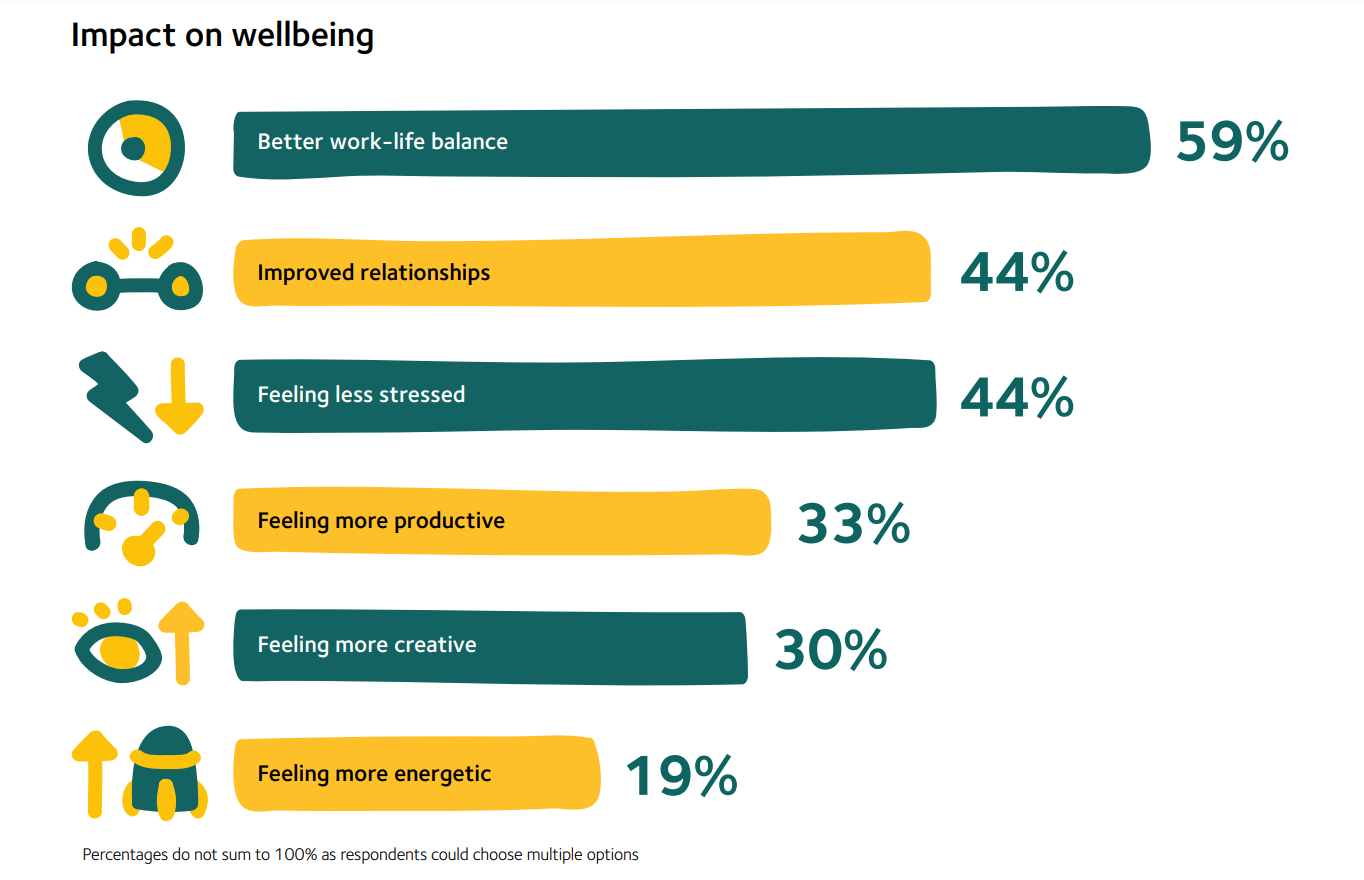
With the longer days and warmer weather, many of us feel the pull of summer, but work obligations often hold us back. Among UK employees, holiday peaks in August. More people take annual leave then compared with any other month of the year.9
And yet, when surveyed in June, over a fifth (22%) of freelancers said they were not planning to take any time off in the next three months.
Considering the substantial and positive impact of taking time off on wellbeing, it is essential for freelancers to take a well-deserved break. Analysis of the research generated some recommendations for how freelancers should prepare for their time away:
1. Manage your clients’ expectations
Managing client expectations is top of the list of things freelancers do when planning a holiday. More than two-thirds (70%) advise their clients they will be taking time off before they do.
This is hardly surprising as previous IPSE research shows that a positive client relationship is a key factor in freelancers’ wellbeing. Working with clients is central to finding and maintaining work. Positive client relationships are also an important source of positive human interaction for many freelancers, given the isolation that can come with working independently.10
2. Budget for your time away
Two in five freelancers financially prepare for taking time off. This includes setting money aside for holidays, as well as budgeting for lost days of work.
Going on holiday often places double financial pressure on freelancers: they not only take on the financial costs of their holiday, but also lose money for the time spent away from their self-employed work because they do not receive holiday pay.
3. Organise your workload
Many freelancers see workload planning as a key part of preparing for time off. For some, this includes working more hours to prepare for their holiday, while for others it simply means avoiding taking on new contracts.
Taking a holiday is not always easy, but planning ahead can reduce pre-holiday stress and allow for full relaxation while away.
Even though freelancers take a number of steps to effectively prepare for their time off, many still work while they are away. In fact, only one in five (22%) don’t work when they are on holiday.
The majority of freelancers (58%) reply to work-related emails on their holiday and a third (37%) also respond to work-related calls. And the work isn’t limited to communication. Many work on projects remotely (28%) and even find or take on new projects (20%) on their holidays.
What is the impact of this ‘always on’ culture?
People who work during their holiday report higher levels of job-related stress. But that doesn’t necessarily mean everyone is affected in the same way.
Psychological research suggests that some people are natural ‘integrators’ and prefer the blurring of boundaries between work and personal time, while other people are natural ‘segmenters’ who prefer to separate their personal life from their work.11
This means that working on projects while on holiday is a positive choice for some people. However, for others, it can potentially be related to a desire to maintain a positive client relationship or earn more money.
Beyond client work, a fifth of freelancers undertake business administration activities while they are on holiday. This includes taking care of their accounting and bookkeeping (22%), and chasing late payments from clients (21%).
Previous IPSE research has found that the average freelancer spends 20 days a year chasing late payments,12 and for 43 per cent of freelancers the result is not being paid at all.13 It is extremely concerning that the anxiety associated with chasing late payments also transfers to freelancers’ spare time – especially when they are on holiday.
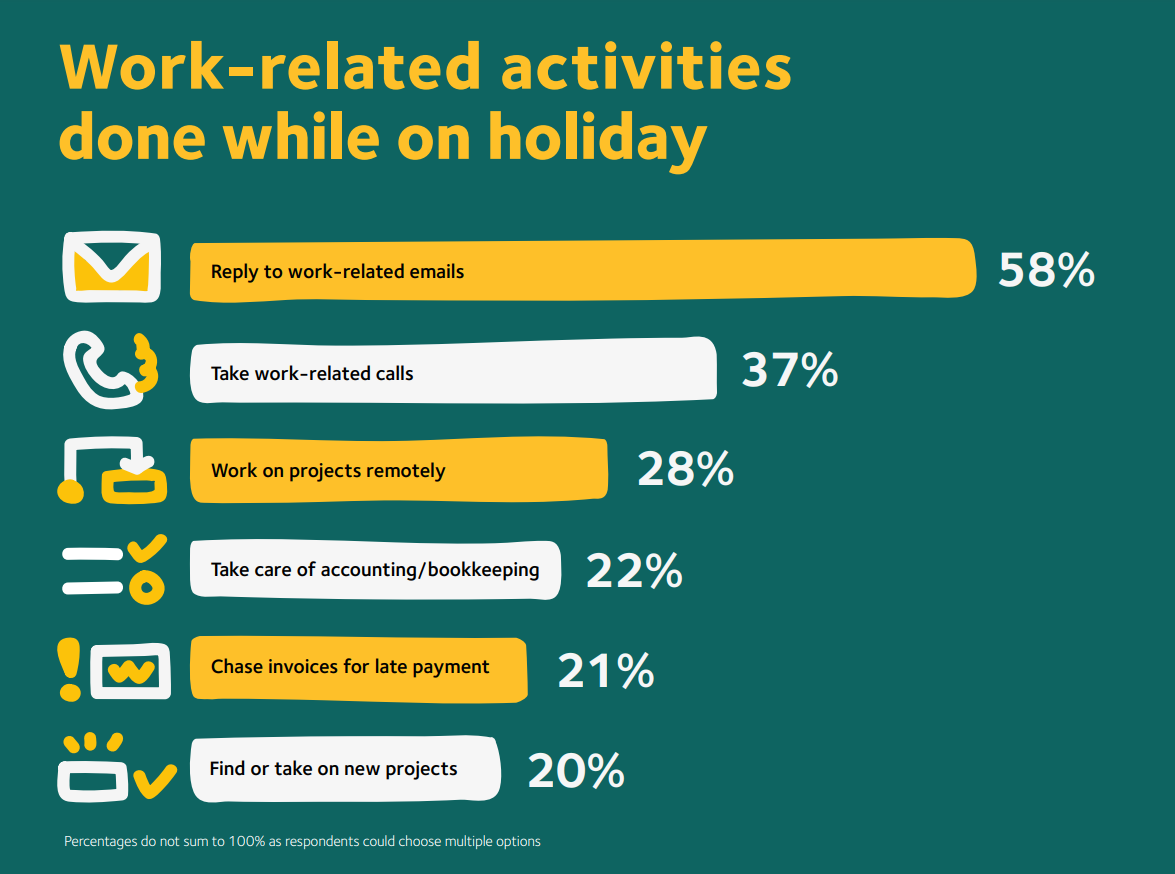
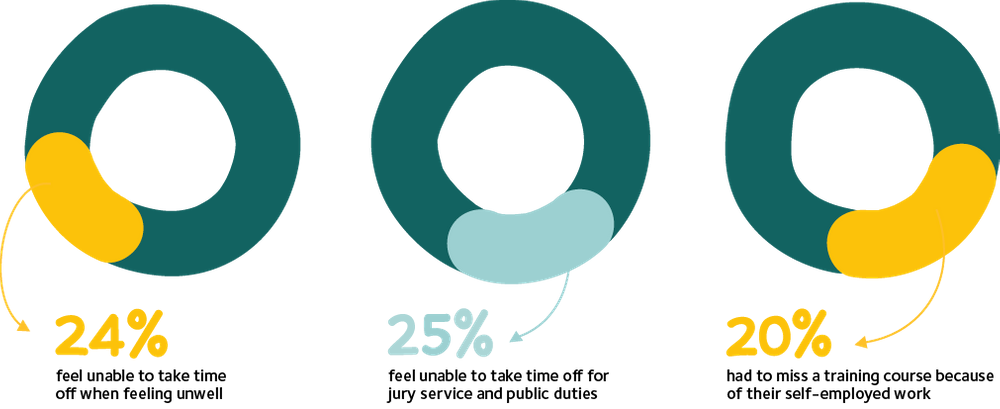
On the whole, freelancers feel able to take time off for personal commitments such as attending a funeral, going on holiday, caring for a family member or a loved one, or attending a wedding.
A quarter of freelancers feel unable to take time off when feeling sick or unwell, which might be associated with the fact that they are not entitled to sick pay or struggle to find a substitute for their work. A quarter of respondents also said they had missed or cancelled a medical appointment because of their self-employed work.
A quarter of freelancers also feel unable to take time off for jury service and public duties or for study and training, while a fifth missed a formal or informal training course for work.
This is concerning given that continuing training and development is essential for freelancers to keep abreast of technological, economic, legal and other changes. Upskilling is especially beneficial for those who earn a lower income as it allows them to expand their skill set and enhance both their confidence and earning potential.14
Freelancers also had to miss personal commitments like holidays, as well as family occasions such as birthdays and anniversaries because of their self-employed work.
The key reason that freelancers feel unable to take time off for personal commitments is that they are trying to meet their client expectations, especially not wanting to let their clients down (62%) and not wanting to cause project delays (46%).
Being a freelancer means being master of your own destiny, but for many it also means not being able to predict when your next contract or project is going to be in place. That is a further reason freelancers feel unable to take time off. Common worries include: future periods of little or no work (60%), not wanting to lose money when they can be working instead (57%) and not wanting to refuse new projects (46%).
Women seem to be more concerned than men about both their financial situation and future periods without work. Over half report not having enough savings in place to take days off (57%) or being afraid of losing contracts while away (54%), compared with only about a third of men (33% and 39% respectively).
The same trend can be observed among younger respondents. What the two groups have in common is that both women and younger freelancers tend to earn less than men and older freelancers: therefore their financial situation is more likely to be affected by taking a holiday.
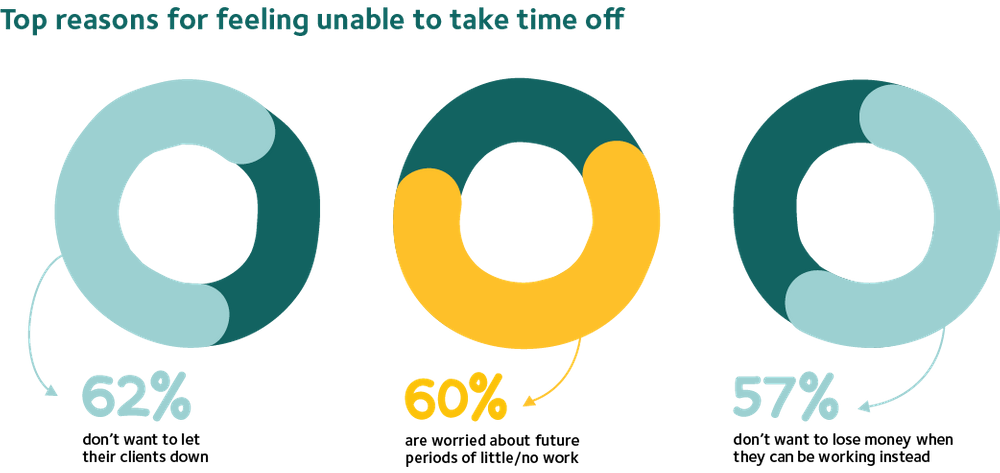
Previous research has shown that the most common reasons for entering self-employment include freedom, flexibility and control over working hours and space – all features that can be particularly appealing to new parents.15 In fact, one in eight of all self-employed people are working mums and the number of mothers in self-employment has risen by 54 per cent since 2008.16
The research shows that freelancers take approximately six weeks (28 days) of parental leave after the birth or adoption of their child and one in six (16%) take no days off at all. In comparison, UK employees are eligible for up to 37 weeks of paid leave shared between the two parents.
Existing parental leave policies do not reflect the needs of the self-employed, who are currently not eligible for Maternity or Paternity pay – or Shared Parental Leave (SPL). It is likely that this is why many freelancers take fewer days off for parental leave.
Self-employed mothers are entitled to a Maternity Allowance and can work up to ten Keeping in Touch (KIT) days while they are on it but this is not always enough to maintain a self-employed business. If they work for more than ten days, the Department for Work and Pensions (DWP) decides how much Maternity Allowance they will lose and deducts that amount.
Taking time off is important for enhancing freelancers’ wellbeing, contributing to a better work-life balance, improved personal relationships and reduced levels of stress.
Concerningly, a fifth of freelancers do not plan to take any holidays in the next three months, while one in ten did not take any time off in the last year. Some freelancers also feel unable to take time off for personal commitments such as attending a training course or when feeling unwell.
While freelancers shared some useful tips on how to effectively prepare for holidays and avoid pre-holiday stress, we set out some additional recommendations on what more they can be doing, as well as what Government and industry can do to ensure freelancers and the wider self-employed population are better catered for when taking time off:
Appendix


